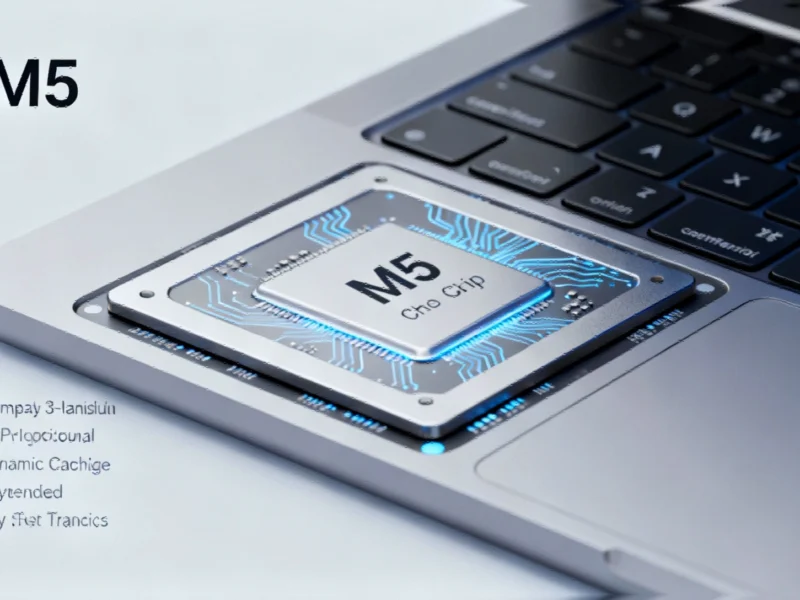In a landmark announcement that redefines the boundaries of mobile computing, Apple has introduced the M5 chip, a revolutionary silicon architecture designed to deliver unprecedented on-device artificial intelligence capabilities. This breakthrough represents what senior vice president Johny Srouji describes as “the most significant leap in Apple’s silicon journey,” fundamentally transforming how AI processes run across MacBook Pro, iPad Pro, and Vision Pro devices.
The M5’s arrival comes at a pivotal moment for on-device AI capabilities, as Apple positions itself to compete in an increasingly crowded marketplace where processing power and efficiency determine user experience. According to industry analysis from Factory Tech News, this development could reshape how consumers interact with AI across their daily devices.
Architectural Breakthrough: Third-Generation 3nm Technology
Built on advanced third-generation 3-nanometer technology, the M5 represents Apple’s most sophisticated chip design to date. The architecture features Neural Accelerators integrated directly into every core, delivering what Apple claims is over four times the GPU compute power of the M4 chip and more than six times that of the groundbreaking M1. This manufacturing advancement comes as competitors like OpenAI invest heavily in AI infrastructure, making Apple’s on-device approach particularly noteworthy.
Revolutionary GPU and CPU Performance
At the heart of the M5 lies a completely redesigned 10-core GPU engineered for both speed and thermal efficiency. Apple has implemented what it calls “the world’s fastest performance core” within the CPU, resulting in 15% faster multithreaded performance compared to the M4. Graphics performance sees an even more dramatic 45% uplift, with third-generation ray tracing and rearchitected dynamic caching enabling smoother gameplay and more responsive 3D applications.
The media engine has been substantially updated to handle heavier creative workloads, making professional applications like Final Cut Pro and Adobe Creative Cloud significantly more responsive. This enhanced performance arrives as security concerns around creative software platforms continue to evolve, highlighting the importance of both performance and protection.
Neural Engine: AI Processing Without Compromise
Apple’s 16-core Neural Engine represents the centerpiece of the M5’s AI capabilities, working in perfect synchronization with GPU accelerators to process everything from diffusion models in creative applications to large language models running locally through platforms like webAI. This unified architecture eliminates the need for cloud dependency, ensuring that sensitive data remains on-device while delivering faster execution for Apple Intelligence features.
Tools like Image Playground and Genmoji now generate results with significantly reduced latency and lower power consumption, creating a more seamless user experience. The M5’s approach to local AI processing stands in stark contrast to cloud-based systems that have faced security challenges, positioning Apple’s solution as both powerful and privacy-focused.
Memory and Efficiency: Powering Demanding Workloads
With 153 GB/s of unified memory bandwidth—nearly 30% higher than the M4—and support for up to 32 GB of memory, the M5 provides the necessary headroom for running larger AI models and juggling demanding creative workloads simultaneously. Users can work with multiple 8K video streams in Final Cut Pro while running complex Photoshop filters and AI-assisted tools without performance degradation.
Remarkably, this performance boost comes with improved energy efficiency. The chip draws less power per operation, contributing to Apple’s broader environmental goals and 2030 carbon-neutral commitment while extending battery life across mobile devices.
Vision Pro Transformation: Enhanced Spatial Computing
For Apple Vision Pro, the M5 delivers approximately 10% more rendered pixels and supports up to 120Hz refresh rates, resulting in crisper details and reduced motion blur across spatial applications and 3D experiences. The micro-OLED displays showcase noticeably sharper visuals and more fluid performance, potentially revitalizing developer interest in the platform amid previous concerns about limited immersive content.
This visual enhancement could mark a turning point for spatial computing, providing developers with the performance headroom needed to create more sophisticated applications and giving existing users compelling reasons to reengage with the device.
Developer Advantages: Seamless Integration
For the development community, the M5 offers automatic performance gains through Apple’s established frameworks. Applications utilizing Core ML, Metal Performance Shaders, Metal 4, or the Foundation Models framework can immediately leverage the chip’s Neural Accelerators without code modifications. For more specialized implementations, developers can program the accelerators directly using Tensor APIs, creating tighter integration between AI design and real-world performance.
Availability and Industry Impact
The M5 chip begins its rollout in the 14-inch MacBook Pro, iPad Pro, and Apple Vision Pro, with preorders currently available. This synchronized launch across multiple product categories represents Apple’s commitment to establishing a unified hardware ecosystem built around native AI processing capabilities.
As the industry watches this development unfold, the M5 positions Apple at the forefront of the on-device AI revolution, challenging conventional wisdom about what’s possible without cloud dependency and setting new standards for performance, efficiency, and user privacy in the artificial intelligence landscape.
Based on reporting by {‘uri’: ‘techrepublic.com’, ‘dataType’: ‘news’, ‘title’: ‘TechRepublic’, ‘description’: ‘Providing IT professionals with a unique blend of original content, peer-to-peer advice from the largest community of IT leaders on the Web.’, ‘location’: {‘type’: ‘country’, ‘geoNamesId’: ‘6252001’, ‘label’: {‘eng’: ‘United States’}, ‘population’: 310232863, ‘lat’: 39.76, ‘long’: -98.5, ‘area’: 9629091, ‘continent’: ‘Noth America’}, ‘locationValidated’: False, ‘ranking’: {‘importanceRank’: 199473, ‘alexaGlobalRank’: 3969, ‘alexaCountryRank’: 2546}}. This article aggregates information from publicly available sources. All trademarks and copyrights belong to their respective owners.



